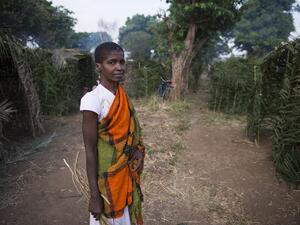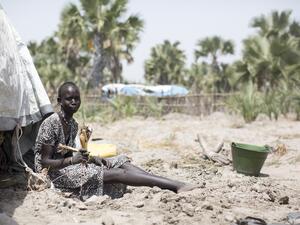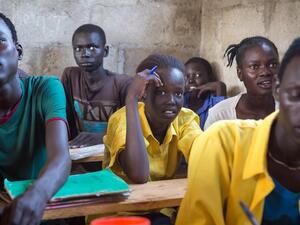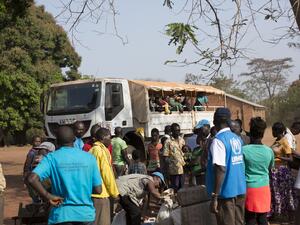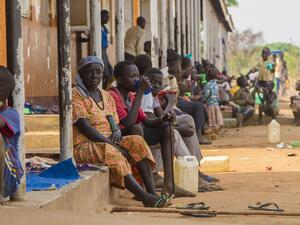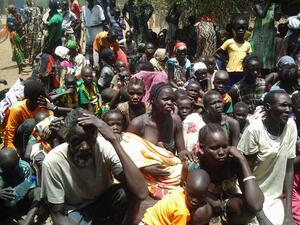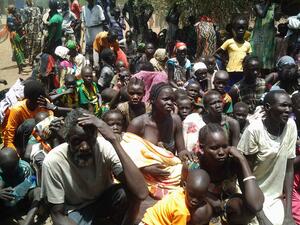UNHCR faces challenges helping Sudanese refugees in Ethiopia
UNHCR faces challenges helping Sudanese refugees in Ethiopia
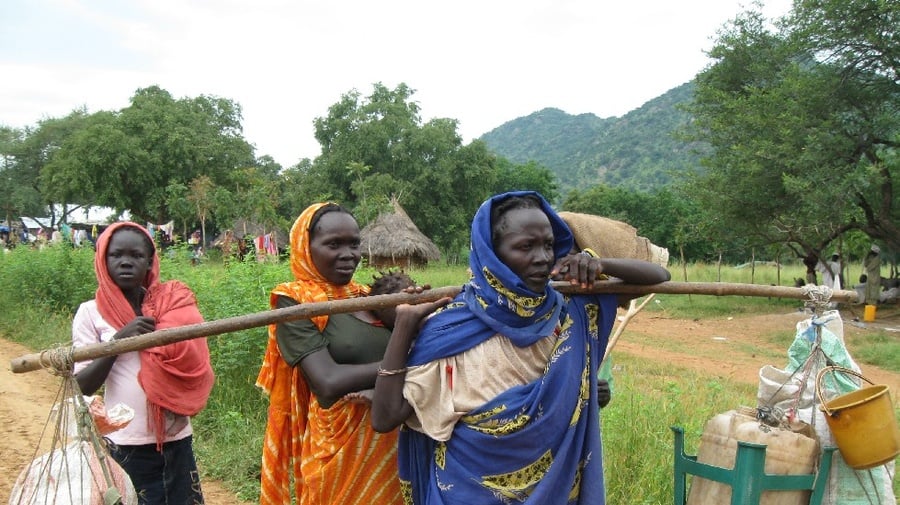
Sudanese women arrive in the Ethiopian part of Kurmuk after fleeing their country.
KURMUK, Ethiopia, October 11 (UNHCR) - Gisman Usman slept when the Antonov bomber arrived. She didn't hear its drone, even when it circled her village in the Sudan. And so when the 20-year-old woke to the blast of a bomb ripping away the back of her tin roof house, the first thought in her mind was to run. But she couldn't move. In an instant, her left leg had become nothing.
Her grandmother died in the explosion. Her mother Soria Ibrahim, 40, called for a car to take Gisman to the nearest hospital and donated her blood for a transfusion before a surgeon performed an amputation.
The bombing continued and after the operation it was decided that it would be too dangerous to stay in the area. The family then headed by donkey cart to Ethiopia, via Kurmuk, which straddles the border with Sudan. The town is separated by a river, which also forms the border.
Since the beginning of September, multiple clashes between the Sudanese army and rebels from Blue Nile state have prompted 50,000 civilians to flee their homes and more than 27,000 to cross into Ethiopia from Kurmuk, Geissan and other locations in Sudan.
The UN refugee agency has accommodated some 5,500 new Sudanese arrivals at the Sherkole camp, some 50 kilometres from the border. UNHCR, in support of the Ethiopian government, is providing hot meals, water and sanitation, while preparing refugees to leave to safer locations. Most, however, continue to stay close to the border, hoping to return soon.
The task before the agency is immense. The Ethiopian government allocated new sites at Tongo, Bambasi and Gure, each with a capacity to accommodate up to 10,000 refugees when completed.
Ground must be cleared for the new sites and latrines, water points and health posts established. UNHCR will also set up a transit centre near Adimazin for refugees moving towards the camps.
"The good news is that the government of Ethiopia has opened its gates and let people in," said Moses Okello, UNHCR's representative in Ethiopia. "There is a strong willingness on their part to generously assist these refugees."
Beyond the sheer logistics of establishing camps and transit centres and providing shelter and basic aid items, there are other major challenges. Convincing people waiting near the border to move to safer locations is no easy task. The displaced worry about their homes and those left behind.
UNHCR would like to set up its camps at least 50 kilometres from the borders to ensure the safety of refugees amid continuing fighting across the border, including air attacks. But many of them fear the refugee agency will send them off to locations several hundred miles away from their homes.
The new camp at Tongo, which opened last week, is more than 200 kilometres from Kurmuk - the busiest border crossing.
"They are people who have just fled and the trauma is still there," said Richard Ewila, head of the UNHCR office in nearby Assosa. "They're not sure of their future. We need to step in to let them know that . . . we are there for them."
Visiting the refugees on the Ethiopian side of the border, Okello has seen the Antonov bombers attacking targets inside Sudan. While he is adamant about the importance of making sure that refugees are removed from harm's way, he also insists that people at the border are treated with dignity and respect.
During an early visit last month, the area where asylum-seekers congregated was filled with mud after two days of rain. While 20 cubicle latrines had been erected, no one had worked to enforce hygiene standards and human waste could be seen everywhere. A water bladder had arrived but needed to be refilled. If this continued, the area would soon become a vector for disease.
Okello was quietly fuming. He knows that it is imperative that any area where refugees congregate must be kept as clean as possible in order to avoid the spread of disease, and to uphold the dignity of the refugees.
"You are going to clean this place up," he said, in a slow firm voice to those working in the area. "I am not leaving here until this site is clean." The representative's mood produces shockwaves and soon a team of workers with wheelbarrows arrive to cover the mud with fresh dirt. The situation has much improved since that visit.
Meanwhile, the newly arrived refugees in Sherkole camp registration centre are curious and hopeful. Lucia Hassan has just finished registration and fingerprinting with UNHCR and a smile has come to her face. She holds her nine-month-old son Paul in her arms.
She recalled fleeing with the boy when an Antonov arrived over the Sudanese part of Kurmuk. Lucia feared that if she looked at the plane, she would be spotted by the pilot.
After the attack, her immediate family and other relatives crossed into Ethiopia to await an uncertain future. "I don't know whether it will be good or bad because I just came," she said. "But here [in Sherkole camp], now somehow I feel okay. There are no bombs and that is good."
Nearby, among the 75 tents erected on what was once a football pitch, people were making the first tentative steps towards an existence that can be considered as relatively normal. Among the tents, people gathered together to participate in an impromptu coffee ceremony.
Families sat on the ground and talked while their children played nearby. "I wish I were home, but I am happier here [than on the border]," said Titus Abdel Bagi, 25, who arrived last month. "Here we have food and shelter. On the border there is conflict and many problems."
By Greg Beals in Kurmuk, Ethiopia


